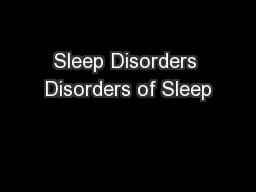

58 Adults Snore 36 Complain of Insomnia 15 note persistent Excessive Daytime Sleepiness 3 Unusual Nocturnal Behaviors 28 Workforce on night or rotating shifts One in Three Individuals are Dissatisfied with Their Sleep ID: 654545
Download Presentation The PPT/PDF document "Sleep Disorders Disorders of Sleep" is the property of its rightful owner. Permission is granted to download and print the materials on this web site for personal, non-commercial use only, and to display it on your personal computer provided you do not modify the materials and that you retain all copyright notices contained in the materials. By downloading content from our website, you accept the terms of this agreement.
Slide1
Sleep DisordersSlide2
Disorders of Sleep58% Adults Snore
36% Complain of Insomnia15% note persistent Excessive Daytime Sleepiness3% Unusual Nocturnal Behaviors28% Workforce on night or rotating shifts
One in Three Individuals are Dissatisfied with Their SleepSlide3
Age and Sleep DisordersSlide4
Traditional classification of sleep disorders
Dyssomnias: They are associated with difficulty initiating or maintaining the sleep or daytime sleepiness.Parasomnias:
A
bnormal behavioral or physiological events occurring during sleep but don’t involve the sleep mechanisms
.Slide5
Primary and Secondary Disorders
Traditionally, sleep disorders have been divided into primary and secondary
disorders.
Primary sleep disorders
result from an endogenous disturbance in the sleeping mechanism, often complicated by learned behaviours.
Secondary sleep disorders
are said to be the result of another disorder –e.g. depression, pregnancy, respiratory problems or
gastroesophageal
reflux diseaseSlide6
Sleep DisordersCurrently, 107 distinct sleep disorders (82 recognized in ICSD2, 25 proposed)
4 x Disorders to be examined:Sleep ApneaInsomniaNarcolepsy
Somnambulism (sleep walking)Slide7
DyssomniasSlide8
Obstructive Sleep ApneaRepetitive episodes of airway collapse associated with arousals and oxygen desaturation.Patients have hundreds of events per night.Slide9
Sleep Apnea – the factsObstructive Sleep Apnea occurs in;
9-24% Adults Males 3-9% Adult Females
3-15% of Children
More likely with:
Obesity
Smoking,
Narrow airway,
Heart disease
Brain disease
Z
Z
ZSlide10
Problems with Sleep ApneaIncreases the manifestations of other medical and psychiatric disorders:
Heart failure, Stroke, Epilepsy, DepressionSudden infant death syndrome (SIDS) is sleep apnea Slide11
Treatments:Sleeping pills are not perfect—most bind to GABA receptors throughout the brain.
Continued use of sleeping pills:Makes them ineffectiveProduces marked changes in sleep patterns that persist even when not taking the drug
Can lead to drowsiness and memory gapsSlide12
OSA TreatmentSurgeryDental DeviceWeight Loss
MedicationAvoidance of alcoholSleep on sideSlide13
Continuous Positive Airway Pressure
Machine pumping in air
Tube and mask for air supply
Fat blokeSlide14
INSOMNIATotal sleep deprivation compromises the immune system and leads to death.
The disease fatal familial insomnia is inherited—in midlife people stop sleeping and die 7-24 months after onset of the insomnia.Slide15
I. Insomnias – the factsPrevalence: 33
-36%Accompanied with daytime consequences: 10%Last more than 1 year: 85% (persistent insomnia)
Male:female = 1:1.4
Increase with age: above 65 years: 50%Slide16
Qu. Why Are Women Not Getting the Sleep They Need?
Lifestyle impacts sleep;Working mothers (72%) and single working women (68%) are more likely to experience insomnia84% pregnant women report insomnia for a few nights each week
Other factors;
Noise (39%)
Giving care to children (20%)
Pets (17%)Slide17
Other factors causing Insomnia?Primary
insomnia – caused by biological factorsInadequate sleep hygiene (10%)Insomnia due to mental disorder (30-40%)Insomnia due to drug or substanceSlide18
Treatment of Insomnia?
Pharmacologic treatmentTreating the medical or psychiatric conditions Nonpharmacologic: behavioral treatments: normalizing the circadian rhythm
sleep hygiene
cognitive behavior therapy
sleep restriction therapySlide19
Prescribed Anti-depressants 12%
Prescribed Sleep medication 3%Slide20
Pharmacologic treatmentBenzodiazepines
Selective GABA drugsMelatonin receptor sensitising drugsSlide21
Problems with insomnia research?Slide22
3. Circadian rhythm disorders – a circadian rhythm is a body rhythm which occurs once in a 24 hour period e.g. sleep- wake cycleA normal sleep pattern would be 5 cycles of the of the sleep stagesIf the sleep-wake cycle is affected then it disrupts our body clock
E.g. shift workersBut this disorder can occur when there is seemingly no reasonUse of bright lights at certain times can help to reset the body clock & thus the sleep-wake cycle is restoredSlide23
ParasomniasSlide24
NarcolepsySYMPTOMS:Have frequent sleep attacks and excessive daytime sleepiness
Do not go through SWS before REM sleep May show cataplexy—a sudden loss of muscle tone, leading to collapse.Slide25
Causes of Narcolpsy?Narcoleptic dogs have a mutant gene for a hypocretin receptor. Hypocretin normally prevents the transition from wakefulness directly into REM sleep.
Interfering with hypocretin signaling leads to narcolepsy.Slide26
Treatments of narcolepsy?Good sleep hygiene Stimulant drugs to help keep you awake during the day.Sodium oxybate is a medicine that can improve cataplexy and help you sleep at night, which can also reduce daytime sleepiness. However, it is not yet funded by the NHS in many areas. Slide27
SLEEP PARALYSISSleep paralysis
is the brief inability to move just before falling asleep, or just after waking up.It can be broken by being touched by someone.It may be caused by the pontine center continuing to signal for muscle relaxation, even when awake.Slide28
Qu. When do people get the most incidents of sleep paralysis?
Changing sleeping position reduces sleep paralysisSlide29
SLEEP WALKINGSomnambulism
(sleepwalking) occurs during stages 3 and 4 SWS, and may persist into adulthood.25% children will sleep walk, but most adults lose ability.Slide30
(3) REM Sleep Disorder
I was a halfback playing football, and after the quarterback received from the centre, he passed it to me and I’m supposed to go around and then cut back in. As I cut back in there is this big 280-pound tackle waiting so I, according to the rules, shoulder barged him…..
When I came to I was standing in front of our dresser and I had gotten out of bed and run and knocked lamps, mirrors and everything off the dresser, hit my head against the wall and my knee against the dresser -
Schenck et al. (1986)
Slide31
Critique of Sleep Studies?Labor intensiveRequire technologists to attend patient all night
Technologist must score and summarize the physiology for the recording